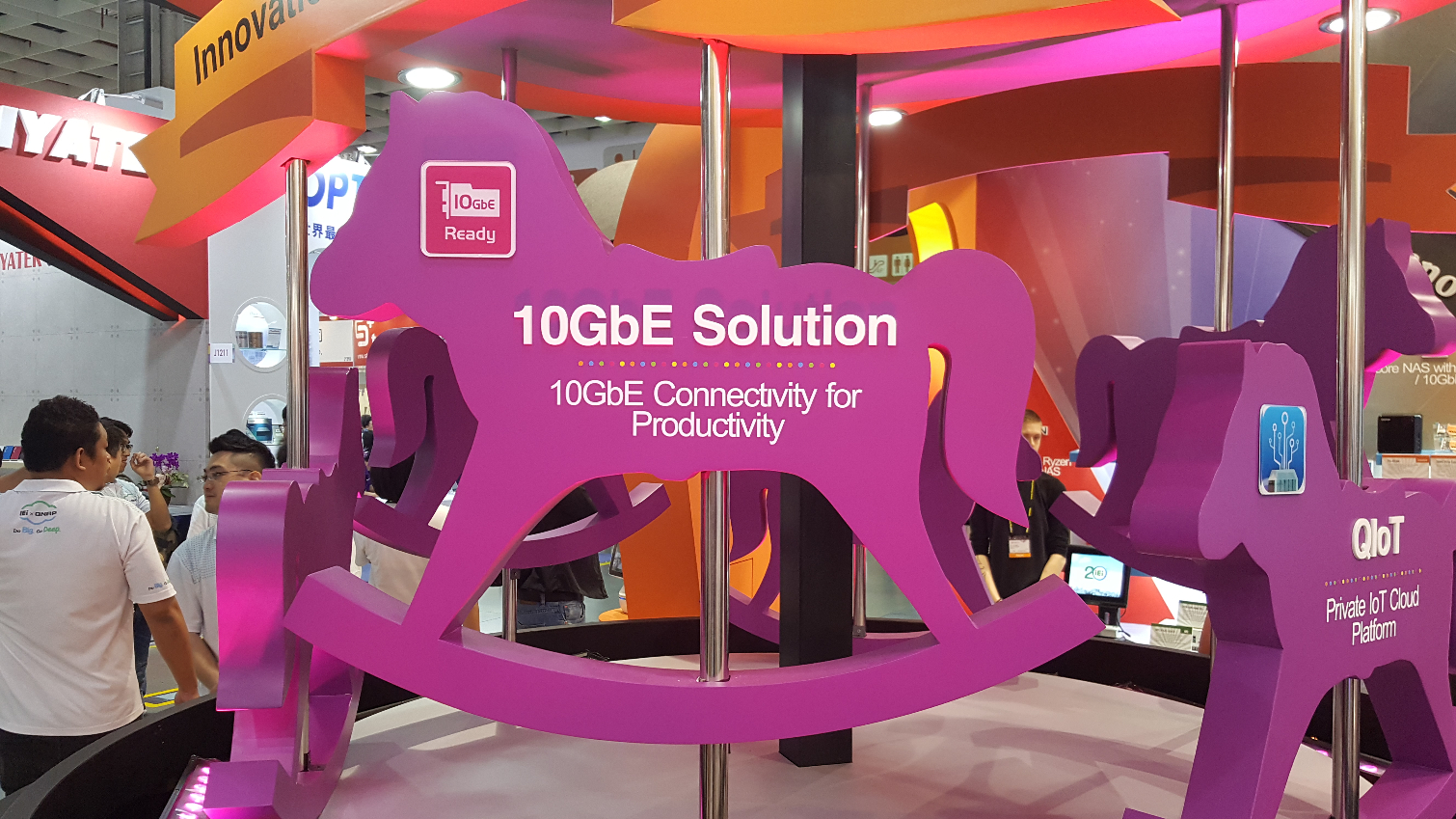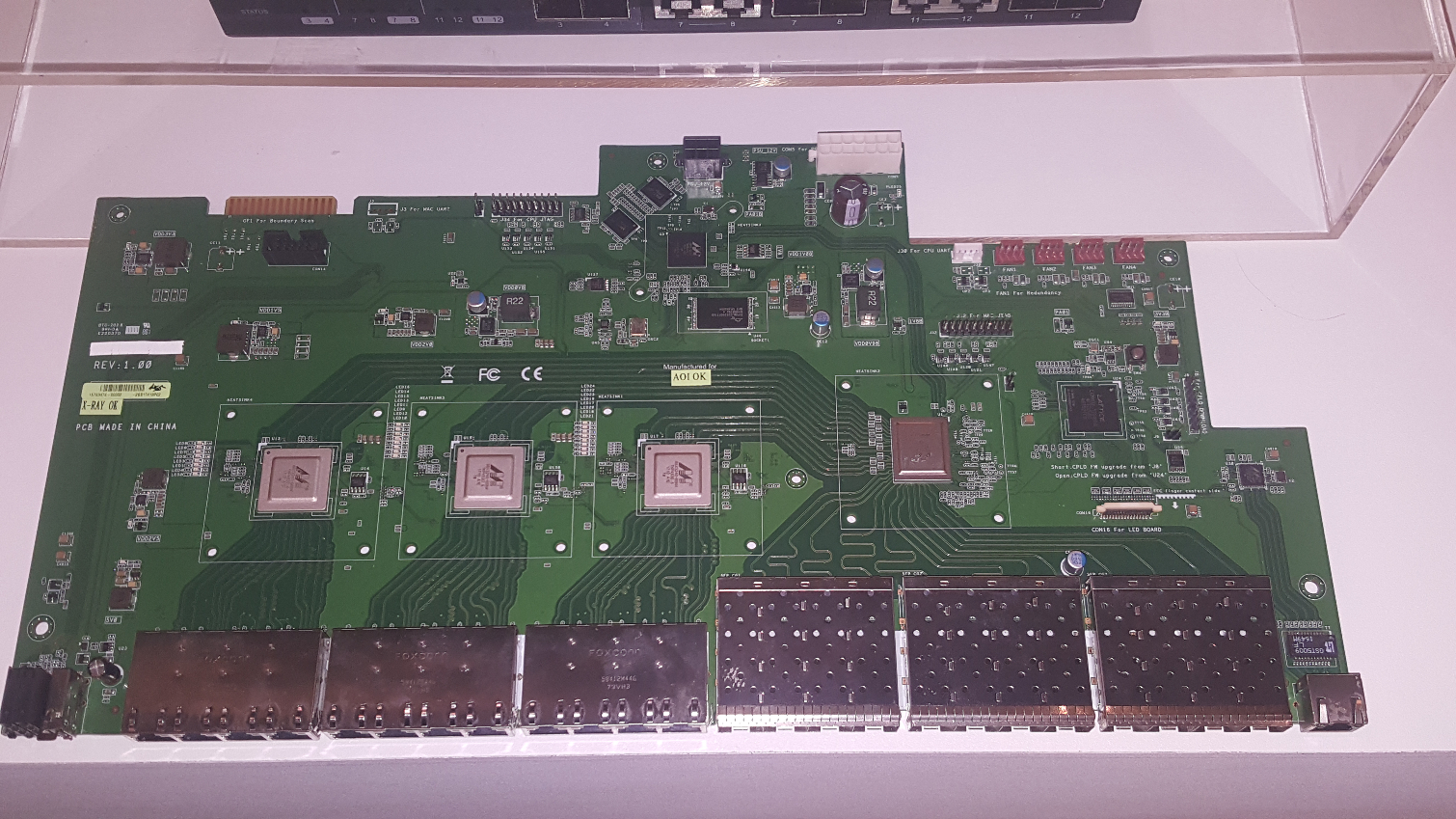Marvell Has Low-Cost 10GbE For Home Users But Demand Is Still Low
Our heart was broken again at Computex 2017 after failing to find multigigabit consumer devices lining the walls from our favorite companies.
Don't get us wrong, year after year we find more devices like desktop motherboards with 10-gigabit and the new 2.5- and 5-gigabit (Multigigabit) Ethernet standard. The high-performance interconnects come on many NAS products either with the technology built-in or as an option with a low-cost add-in card. We've even seen the technology available on NAS systems that cost as little as $500. Yet even with the inclusion in other markets, the feature is only found on premium desktop motherboards designed for enthusiasts or those marketed as "ultimate gaming" boards. The premium price for many of those boards is often higher than the cost of an add-in card, barring a few motherboards released in mid-2017.
We had a special meeting with Michael Zimmerman, VP and GM of the Networking Group at Marvell, to get the latest information on upcoming products. Zimmerman has a wealth knowledge for all things networking. He is an insider with first-hand experience working with companies in the network market from the massive datacenter systems to $39 products sold in big box stores.
Prior to our meeting, Zimmerman met with one of the largest companies responsible for big box sales. We were told there is interest in multigigabit for the home, but the demand is still very low. High speed WiFi and increased Thunderbolt 3 adoption will slow demand for higher-than 1GbE Ethernet even more, since those technologies have already entered commodity status, or will do so in the coming year, in Thunderbolt 3's case. It's our opinion that the multigigabit standard will also hurt the adoption rate of 10GbE, but we understand how older twisted-wire embedded in existing homes makes it a difficult standard to push out into the market. Many homes built in the last decade, when it became fashionable to do so, use Cat 5e, a standard that isn't officially supported for 10GbE speeds.
In the image above we see an enterprise switch. We can use it to break down some of the issues involved. On the left side we see wire 10GbE ports with the typical RJ45 connector. There are twelve total, and for every four you need a PHY. On the other side we also see twelve ports but with the SFP+ connector. Those ports do not require a PHY. The lack of additional silicon in the path is why SFP+ 10GbE switches are more cost effective. If you've shopped for a used 10GbE switch then you already understand the premium involved with the technology over standard RJ45 connectors. SFP+ would be a nightmare in the typical home for many reasons so we won't even try to argue its a reasonable option even though we do use it in our lab.
The PHY adds quite a bit to the overall costs, but they also increase heat in the system. The cooling components required to manage those raised temperatures, as well as more complex designs, further increase cost.
Marvell has designs that move the PHY to software, but that increases the CPU power required. The company also has smaller versions of the silicon shown on this reference design that reduce the port count and overall cost. Most home users don't run a switch in addition to a network router. It would be interesting to see how many users, even power users, purchase a router and replace the free or monthly fee unit given by the service provider. If we are waiting on Comcast and other providers to adapt 10GbE or multigigabit then hell may actually freeze over before that time comes. If there is one thing we know, deploying high-speed connections, in the U.S. system of government-endorsed internet monopolies, is a slow process.
Get Tom's Hardware's best news and in-depth reviews, straight to your inbox.

Chris Ramseyer was a senior contributing editor for Tom's Hardware. He tested and reviewed consumer storage.
-
InvalidError I don't see how moving PHY to software makes much sense as the hardware implementation is far more power-efficient and space-efficient than a software-based equivalent with the associated much stronger CPU requirement. The biggest overheads for power and area are the ADCs, DACs and analog amplifiers which are still required either way.Reply -
thundervore We need 10GbE in homes now!!!! I have a 1Gb network at home and it crawls when im accessing my server trying to back up a computer while pushing content to 3 TVs and torrenting. My switch get abused that's connected to the server.Reply -
dstarr3 Well, there just aren't that many homes yet that have ethernet in the walls, let alone CAT6 or CAT7. My house was built ten years ago and I'm lucky enough to have ethernet jacks in every room, but it's CAT5e, so I'm not going to break the 1Gb barrier anytime soon. So if you want a house with CAT6 or CAT7, you either need to buy a very recently built house, or have it installed in your own house.Reply
That, and American internet is pathetic and simply no one has the need to wire their house up with anything more. It's just reserved for enterprise and the tech enthusiasts at this point. The enterprise sector has no interest in budget components as hardware cost isn't a concern, and the tech enthusiasts are a very small niche that never will represent a significant market space. -
Vatharian I've read the article couple of times, to make sure I didn't missed anything, or if there was some line I missed. That's load of bullcrap! They're looking at the effects and completely mistaking them for the cause.Reply
First, Thundrbolt 3 has absolutely NOTHING to do with networking. Number of devices supporting it is minuscule, and while they have 'wow' factor for using really extreme interface, they are far from common.
Second, high speed WiFi is the main factor pushing for 10GbE at home environment. What's the point of 1.7 Gb/s+ connection, when all you can do is mere 1 Gb/s, because cables? Add a NAS, and here you go, big damn bottleneck, you'd all be the same while using 802.11n. MIMO? What for?
Third, normal home users would love to have 10 GbE, if there was absolute lack of switches. Give us affordable 8 or 12 port 10 GbE switches. Consider routers presenting 6x 10GbE LAN ports (vendors that put 4 RJ45s on routers are the root of all evil!). You want to see good penetration and have cheap solution? USE IT! Soon, EOLed and deprecated enterprise equipment supporting 10G will start popping on auction sites, and it's selling like hot cakes - It's the same when 1G saw big adoption spike. But times have changed, and it's not ideal solution for many. Again, want sales - give us something we can buy!
Next thing is, quit yapping, that there is lack of content that would benefit from 10 GbE at home. Now, mostly true. See 10% market share, and grab popcorn and watch what happens.
There is considerable number of people, who still sport 100 Mb/s networks at home, because when they were lying down the infrastructure, 1G was prohibitively expensive. Their lousy low quality Cat 5 cables won't support 10GbE, and not even 2.5 or 5G. But... it's around the time, when they are renovating their homes - there is great sales potential there.
Next thing, going completely wireless is really the last thing we want. Forget about security (or lack of it) for a moment, but in most places where more than 2-3 famililes live close enough, 2.4 GHz is completely cramped, and 5GHz is starting to see congestion problems. Then, secure, stable and fast wireless is NOT plug and play.
Finally - we don't want half-baked and half-assed solution like 2.5 and 5G. It's a waste of effort, and looking for a niche that doesn't exist. This technology is already outdated! -
InvalidError Reply
People who are still on 100Mbps on their LAN would be more than happy with 1Gbps for the foreseeable future and most aren't going to be looking at 10G any time soon. Also, even cat5 can handle 10GBase-T over shorter distances with the newer variants stretching copper even further due to the number of companies preferring to pay for more complex PHY chips over having their offices rewired. That's how 1GBase-T which worked on cat5 ultimately displaced the cheaper 1GBase-TX standard which required cat6a.19766168 said:There is considerable number of people, who still sport 100 Mb/s networks at home, because when they were lying down the infrastructure, 1G was prohibitively expensive. Their lousy low quality Cat 5 cables won't support 10GbE, and not even 2.5 or 5G.
-
CRamseyer Let me change you mind on some of those points.Reply
Thunderbolt 3 devices and 10GbE with a NAS do share some target markets that benefit from high-speed connected storage. Think video editors and photographers. Thunderbolt 3 will gain market share next year when Intel brings the technology on the CPU die as announced just a few days ago. Everyone interested in 10GbE for the home would rather have a high-speed Ethernet connection but TB3 will be easier since we don't have the switches ready.
2.5GbE is powerful enough for the new WiFi Devices. Both it, and 5GbE, will operate over Cat 5e.
EBay is full of low-cost surplus 10GbE switches that were ripped from data centers but most sound like a jet plane. Most people can't live with the sound of a spooled up turbo charger sitting on the desk. Asus had the right idea with the XG-U2008 but it only gives users access to two 10GbE ports. -
InvalidError Reply
How many people are going to need more than a pair of 10G ports on a home router/switch? One port for the NAS, one port for the workstation/main PC sees the bulk of all significant use, most other devices in a typical home aren't going to need more than 1Gbps on a frequent enough basis to justify the additional cost and power any time soon. Personally, I prefer keeping my backups offline using an external USB3 HDD where malware like WannaCry can't touch 'em.19766638 said:Asus had the right idea with the XG-U2008 but it only gives users access to two 10GbE ports. -
dstarr3 Reply19766638 said:Thunderbolt 3 devices and 10GbE with a NAS do share some target markets that benefit from high-speed connected storage. Think video editors and photographers.
The vast majority of video editors and photographers don't have the cash to have all of their data stored on SSD arrays. Rather, they're still using hard drives. Huge capacity, low cost per gig. And if all your data is stored on HDDs, you're not going to see a performance boost by switching to 10GbE. A hard drive at full sequential speed just barely fails to saturate even 1GbE.

